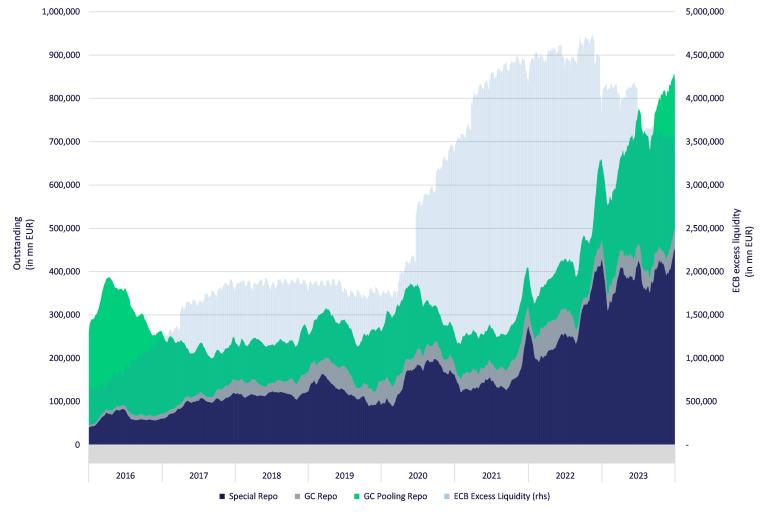Repo market participants find themselves in a very different market in 2024, with collateral scarcity seemingly in the rearview mirror amid a “higher for longer” interest rate environment mixed with a number of unknowns related to European and global monetary and regulatory policies. In advance of Finadium’s upcoming Rates & Repo Europe conference on March 14, we speak with experts from Eurex Repo and GLMX, who will be on the Market Conditions in the UK and Europe panel. about how that’s translating to volumes and operational realities.
Over the last year, Eurex Repo has seen a surge in variety of clients – buy-side, global custodians, central banks – in addition to its traditional core European bank client base. This has been driven by market conditions related to rising interest rates, as well as the end of a variety of central bank programs, which can also be credited for a surge in Eurex Repo volumes, explained Katja Renner, who leads build out of the repo buy-side business at Eurex in FIC & Repo
“A lot of market participants started looking for alternative routes to access liquidity in an efficient and fast way, and this is where our GC pooling product has had a massive revival last year,” she noted. On the buy-side meanwhile, the LDI crisis in the UK served as a catalyst and accelerator, and asset managers were reminded of the fact that they need to be able to convert collateral into cash and vice versa in a very short period of time.

No conformity
Repo market conditions in Europe are dynamic and the numerous moving parts raise big questions on how any increased costs are going to filter through for participants, said Andy Turvey, director of Sales for GLMX, a global technology platform for trading money market instruments, including repo and securities lending.
For example: if there is more demand for capacity at a time of increasing dealer costs to provide it, how does that reshape the competitive landscape? Will there be a type of regulatory arbitrage as firms reposition? Would hedge fund clients be willing to pay pass-through costs? “There’s going to be no conformity in how those costs are passed down on a business level,” he said.
Collateral scarcity is a thing of the past and while issuance remains broadly unchanged, the European Central Bank’s (ECB’s) quantitative tightening program is expected to result in a lot more bonds coming back to the street, he added. At the same time, Basel III Endgame is going to have a significant impact on institutional capacity to provide financing.
“Only by an open and honest exchange between the buy-side and the sell-side, will we come up with a market structure that will enable us to continue to build out the repo markets within a robust and resilient infrastructure and allow the market to continue to be liquid despite the numerous headwinds and challenges which we see coming from a multitude of external factors,” he said.
Repo models
To some extent, this dynamic is rolling into greater engagement for third-party solutions, and Turvey said that there’s a lot more interest from the buy-side to consider indemnified repo, guaranteed repo, peer-to-peer repo and clearing, albeit with the caveats that participants go where the liquidity is, there’s risk in being an early adopter, and “anything that you want to achieve in this market takes a long time”.
Specific to buy-side clearing, Eurex’s Renner stressed that it’s not constrained to any one model, and there are three access models with a fourth expected by the end of 2024 that is tailored for hedge funds. Each model has different market options as well as obligations for members and participants, and can be split into sponsored and non-sponsored categories.
Moreover, there are moves to reduce ancillary costs across the board, for example: cross-product margining between single ISIN repo and listed derivatives futures is in the works and can be expected to significantly lower margin requirements.
2024, she noted, is going to be about efficiency across several dimensions: margin, balance sheet and settlement. The latter should also be understood in the context of the European Collateral Management System (ECMS) going live in November: “This creates multiple opportunities for clients on our side.”


